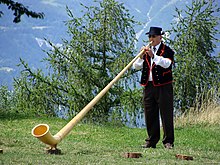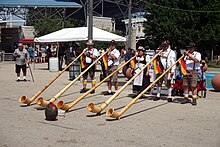
A brass instrument is a musical instrument that produces sound by sympathetic vibration of air in a tubular resonator in sympathy with the vibration of the player's lips. Brass instruments are also called labrosones or labrophones, from Latin and Greek elements meaning 'lip' and 'sound'.

The cornet is a brass instrument similar to the trumpet but distinguished from it by its conical bore, more compact shape, and mellower tone quality. The most common cornet is a transposing instrument in B♭. There is also a soprano cornet in E♭ and cornets in A and C. All are unrelated to the Renaissance and early Baroque cornett.

The French horn is a brass instrument made of tubing wrapped into a coil with a flared bell. The double horn in F/B♭ is the horn most often used by players in professional orchestras and bands, although the descant and triple horn have become increasingly popular. A musician who plays a horn is known as a horn player or hornist.

The saxophone is a type of single-reed woodwind instrument with a conical body, usually made of brass. As with all single-reed instruments, sound is produced when a reed on a mouthpiece vibrates to produce a sound wave inside the instrument's body. The pitch is controlled by opening and closing holes in the body to change the effective length of the tube. The holes are closed by leather pads attached to keys operated by the player. Saxophones are made in various sizes and are almost always treated as transposing instruments. Saxophone players are called saxophonists.

The word lituus originally meant a curved augural staff, or a curved war-trumpet in the ancient Latin language. This Latin word continued in use through the 18th century as an alternative to the vernacular names of various musical instruments.

The natural horn is a musical instrument that is the predecessor to the modern-day (French) horn. Throughout the seventeenth and eighteenth century the natural horn evolved as a separation from the trumpet by widening the bell and lengthening the tubes. It consists of a mouthpiece, long coiled tubing, and a large flared bell. This instrument was used extensively until the emergence of the valved horn in the early 19th century.
The alto clarinet is a woodwind instrument of the clarinet family. It is a transposing instrument pitched in the key of E♭, though instruments in F have been made. In size it lies between the soprano clarinet and the bass clarinet. It bears a greater resemblance to the bass clarinet in that it typically has a straight body, but a curved neck and bell made of metal. All-metal alto clarinets also exist. In appearance it strongly resembles the basset horn, but usually differs in three respects: it is pitched a whole step lower, it lacks an extended lower range, and it has a wider bore than many basset horns.

A natural trumpet is a valveless brass instrument that is able to play the notes of the harmonic series.

A Holztrompete, generally refers to natural trumpets whose conical or cylindrical blowpipe is made of wood and can be from half a meter to five meters long. The best-known wooden trumpet is the Swiss alphorn. Their design and traditional function was as a signaling and warning instrument used by shepherds and sometimes for ritual occasions.
A Ranz des Vaches or Kuhreihen is a simple melody traditionally played on the horn by the Swiss Alpine herdsmen as they drove their cattle to or from the pasture. The Kuhreihen was linked to the Swiss nostalgia and Homesickness.
The Symphony No. 89 in F major, Hoboken I/89, was written by Joseph Haydn in 1787, and performed under the auspices of Nikolaus Esterházy at Esterháza. It is sometimes referred to as The Letter W referring to an older method of cataloging Haydn's symphonic output. The second and fourth movements of this symphony are based on movements of a Concerto for Lire Organizzata in F, Hob. VIIh/5, that Haydn composed in 1786, a year before this work, for Ferdinand IV, King of Naples. To accommodate other orchestras, Haydn had arranged all of his Lire Concertos to be played with flute and oboe as the solo instruments instead of the two lire. Similar substitutions were made adapting the movements into a symphonic form, giving this work a decidedly windband flavor.
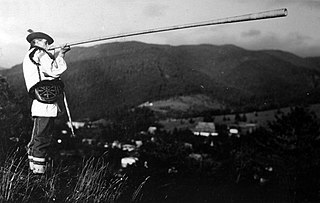
The trembita is a type of an alpine horn made of wood. It is common among Ukrainian highlanders Hutsuls who live in western Ukraine, eastern Poland, Slovakia, and northern Romania. In Poland it is known as a trombita, a bazuna, or a ligawka. Trembita is also one of the Ukrainian folk musical instruments.
The chromatic trumpet of Western tradition is a fairly recent invention, but primitive trumpets of one form or another have been in existence for millennia; some of the predecessors of the modern instrument are now known to date back to the Neolithic era. The earliest of these primordial trumpets were adapted from animal horns and sea shells, and were common throughout Europe, Africa, India and, to a lesser extent, the Middle East. Primitive trumpets eventually found their way to most parts of the globe, though even today indigenous varieties are quite rare in the Americas, the Far East and South-East Asia. Some species of primitive trumpets can still be found in remote places, where they have remained largely untouched by the passage of time.
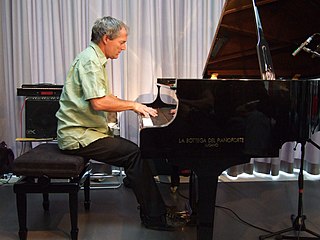
John Wolf Brennan is an Irish pianist, organist, melodica player, and composer based in Weggis, Switzerland.
The medieval lituus was a musical instrument of an indeterminate nature, known only from records which ascribe it various properties. Johann Sebastian Bach's O Jesu Christ, Meins Lebens Licht contains the only known piece of music written for an instrument under this name.

Arkady Shilkloper is a Russian multi-instrumentalist and composer, currently living in Berlin. He is known as one of the best jazz performers on horn and alphorn.

A horn is any of a family of musical instruments made of a tube, usually made of metal and often curved in various ways, with one narrow end into which the musician blows, and a wide end from which sound emerges. In horns, unlike some other brass instruments such as the trumpet, the bore gradually increases in width through most of its length—that is to say, it is conical rather than cylindrical. In jazz and popular-music contexts, the word may be used loosely to refer to any wind instrument, and a section of brass or woodwind instruments, or a mixture of the two, is called a horn section in these contexts.
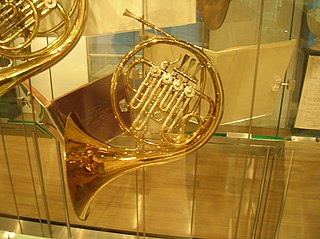
The German horn is a brass instrument made of tubing wrapped into a coil with a flared bell, and in bands and orchestras is the most widely used of three types of horn, the other two being the French horn and the Vienna horn. Its use among professional players has become so universal that it is only in France and Vienna that any other kind of horn is used today. A musician who plays the German horn is called a horn player. The word "German" is used only to distinguish this instrument from the now-rare French and Viennese instruments. Although the expression "French horn" is still used colloquially in English for any orchestral horn, since the 1930s professional musicians and scholars have generally avoided this term in favour of just "horn". Vienna horns today are played only in Vienna, and are made only by Austrian firms. German horns, by contrast, are not all made by German manufacturers, nor are all French-style instruments made in France.
Eliana Burki was a Swiss musician, best known for her unconventional playing of the alphorn. She composed and performed on the alphorn as a lead instrument in multiple genres, including pop, funk and world music. At the same time, she succeeded in creating her own musical niche, which brought her international attention, media coverage and bookings for concerts all over the world.


